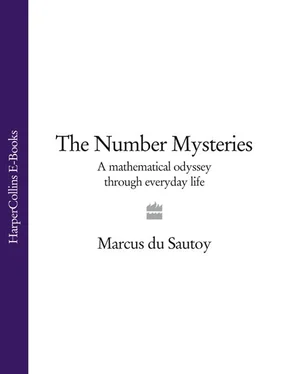The Curious Incident of the Never-ending Primes
1, 2, 3, 4, 5, … it seems so simple: add 1, and you get the next number. Yet without numbers we’d be lost. Arsenal v Man United—who won? We don’t know. Each team got lots. Want to look something up in the index of this book? Well, the bit about winning the National Lottery is somewhere in the middle of the book. And the Lottery itself? Hopeless without numbers. It’s quite extraordinary how fundamental the language of numbers is to negotiating the world.
Even in the animal kingdom, numbers are fundamental. Packs of animals will base their decision to fight or flee on whether their group is outnumbered by a rival pack. Their survival instinct depends in part on a mathematical ability, yet behind the apparent simplicity of the list of numbers lies one of the biggest mysteries of mathematics.
2, 3, 5, 7, 11, 13, … These are the primes, the indivisible numbers that are the building blocks of all other numbers—the hydrogen and oxygen of the world of mathematics. These protagonists at the heart of the story of numbers are like jewels studded through the infinite expanse of numbers.
Yet despite their importance, prime numbers represent one of the most tantalising puzzles we have come across in our pursuit of knowledge. Knowing how to find the primes is a total mystery because there seems to be no magic formula that gets you from one to the next. They are like buried treasure—and no one has the treasure map.
In this chapter we will explore what we do understand about these special numbers. In the course of the journey we will discover how different cultures have tried to record and survey primes and how musicians have exploited their syncopated rhythm. We will find out why the primes have been used to communicate with extraterrestrials and how they have helped to keep things secret on the Internet. At the end of the chapter I shall unveil a mathematical enigma about prime numbers that will earn you a million dollars if you can crack it. But before we tackle one of the biggest conundrums of mathematics, let us begin with one of the great numerical mysteries of our time.
Why did Beckham choose the 23 shirt?
When David Beckham moved to Real Madrid in 2003, there was a lot of speculation about why he’d chosen to play in the number 23 shirt. It was a strange choice, many thought, since he’d being playing in the number 7 shirt for England and Manchester United. The trouble was that at Real Madrid the number 7 shirt was already being worn by Raúl, and the Spaniard wasn’t about to move over for this glamour-boy from England.
Many different theories were put forward to account for Beckham’s choice, and the most popular was the Michael Jordan theory. Real Madrid wanted to break into the American market and sell lots of replica shirts to the huge US population. But football (or ‘soccer’, as they like to call it) is not a popular game in the States. Americans like basketball and baseball, games that end with scores of 100-98 and in which there’s invariably a winner. They can’t see the point of a game that goes on for 90 minutes and can end 0–0 with no side scoring or winning.
According to this theory, Real Madrid had done their research and found that the most popular basketball player in the world was definitely Michael Jordan, the Chicago Bulls’ most prolific scorer. Jordan sported the number 23 shirt for the whole of his career. All Real Madrid had to do was put 23 on the back of a football shirt, cross their fingers and hope that the Jordan connection would work its magic and they would break into the American market.
Others thought this too cynical, but suggested a more sinister theory. Julius Caesar was assassinated by being stabbed 23 times in the back. Was Beckham’s choice for his back a bad omen? Still others thought that maybe the choice was connected with Beckham’s love of Star Wars (Princess Leia was imprisoned in Detention Block AA23 in the first Star Wars movie). Or was Beckham a secret member of the Discordianists, a modern cult that reveres chaos and has a cabalistic obsession with the number 23?
But as soon as I saw Beckham’s number, a more mathematical solution immediately came to mind. 23 is a prime number. A prime number is a number that is divisible only by itself and 1. 17 and 23 are prime because they can’t be written as two smaller numbers multiplied together, whereas 15 isn’t prime because 15=3×5. Prime numbers are the most important numbers in mathematics because all other whole numbers are built by multiplying primes together.
Take 105, for example. This number is clearly divisible by 5. So I can write 105=5×21. 5 is a prime number, an indivisible number, but 21 isn’t: I can write it as 3×7. So 105 can be written as 3 × 5 × 7. But this is as far as I can go. I’ve got down to the primes, the indivisible numbers from which the number 105 is built. I can do this with any number since every number is either prime and indivisible, or else it isn’t prime and can be broken down into smaller indivisible numbers multiplied together.
FIGURE 1.01
The primes are the building blocks of all numbers. Just as molecules are built from atoms such as hydrogen and oxygen or sodium and chlorine, numbers are built from primes. In the world of mathematics, the numbers 2, 3 and 5 are like hydrogen, helium and lithium. That’s what makes them the most important numbers in mathematics. But they were clearly important to Real Madrid too.
When I started looking a little closer at Real Madrid’s football team, I began to suspect that perhaps they had a mathematician on the bench. A little analysis revealed that at the time of Beckham’s move, all the Galácticos , the key players for Real Madrid, were playing in prime number shirts: Carlos (the building block of the defence) number 3; Zidane (the heart of the midfield) number 5; Raúl and Ronaldo (the foundations of Real’s strikers) 7 and 11. So perhaps it was inevitable that Beckham got a prime number, a number that he has become very attached to. When he moved to LA Galaxy he insisted on taking his prime number with him in his attempt to woo the American public with the beautiful game.
A prime number fantasy football game
Each player cuts out three Subbuteostyle players and chooses different prime numbers to write on their backs. Use one of the Euclid footballs from Chapter 2(page 66).
The ball starts with a player from Team 1. The aim is to make it past the three players in the opponent’s team. The opponent chooses the first player to try to tackle Team 1’s player. Roll the dice. The dice has six sides: white 3, white 5 and white 7, and black 3, black 5 and black 7. The dice will tell you to divide your prime and the prime of your opponent’s player by 3, 5 or 7 and then take the remainder. If it is a white 3, 5 or 7, your remainder needs to equal or beat the opposition. If it is black, you need to equal or get less than your opponent.
To score, you must make it past all three players and then go up against a random choice of prime from the opposition. If at any point the opposition beats you, then possession switches to the opposition. The person who has gained possession then uses the player who won to try to make it through the opposition’s three players. If Team 1’s shot at goal is missed then Team 2 takes the ball and gives it to one of their players.
The game can be played either against the clock or first to three goals.
This may sound totally irrational coming from a mathematician, someone who is meant to be a logical analytical thinker. However, I also play in a prime number shirt for my football team, Recreativo Hackney, so I felt some connection with the man in 23. My Sunday League team isn’t quite as big as Real Madrid and we didn’t have a 23 shirt, so I chose 17, a rather nice prime—as we’ll see later. But in our first season together our team didn’t do particularly well. We play in the London Super Sunday League Division 2, and that season we finished rock bottom. Fortunately this is the lowest division in London, so the only way was up.
Читать дальше












